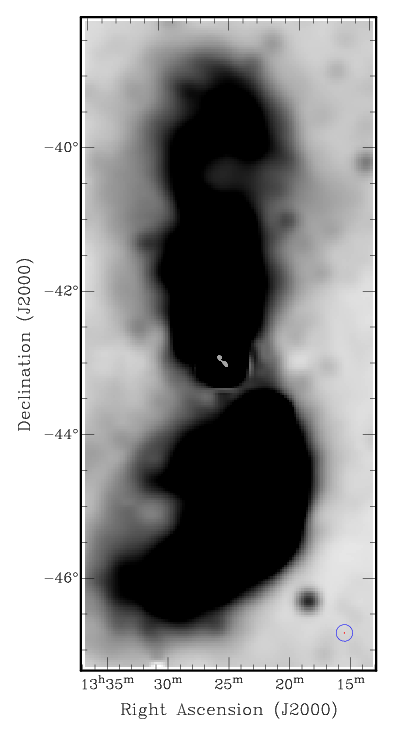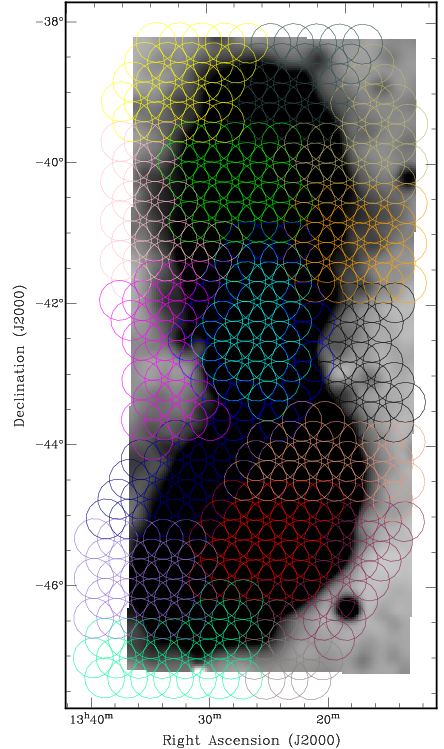Centaurus A
a long overdue synthesis imaging survey
"Surely it's been done" is the typical response I get when I mention that we are going to make an aperture synthesis mosaic of our closest radio galaxy, Centaurus A. But, of course, it really has not ever been done. We are now a quarter of the way through our imaging program and, I am pleased to report, it is by all accounts so-far-so-good. With only half of the required sensitivity, and (more importantly) only a quarter of the uv-coverage, we have a very long road ahead. But the results from the first of the four 750 metre array configurations look promising indeed.

Figure 1: Greyscale optical image (from the Digitised Sky Survey) of NGC 5128, the nearby elliptical galaxy that hosts the radio source Centaurus A. VLA 1.4-GHz radio continuum contours (Clarke, Burns & Norman, 1992, ApJ, 395, 444) are overlaid on the optical image. These radio jets represent less than 1% of the total extent of the radio structure of Centaurus A.

Figure 2: Parkes 1.4 GHz greyscale image (courtesy of Norbert Junkes) overlaid with the same VLA contours as in Figure 1. The bottom right corner shows the angular resolution of this Parkes image (blue circle) with the Compact Array resolution from our current imaging program inset with a tiny red ellipse.
The science goals of this imaging program encompass a wide range of astrophysics. Here I will mention the goals that our team are actively pursuing. Firstly, we will explore elements of feedback (i.e. the interaction, influence and impact) between the radio plasma and physical processes in the intergalactic medium (IGM), like shocks, ionised filaments, star formation and hot gas bubbles. The second science goal is to exploit the strong polarised emission of Centaurus A as a background screen to probe the magnetic fields of foreground sources (galaxies, high velocity clouds, our Galaxy) and as a foreground screen to investigate the Faraday rotation caused by the radio lobes and the IGM into which the lobes are expanding, using lines of sight to the hundreds of polarised background sources.

Figure 3: Parkes 1.4 GHz greyscale image (courtesy of Norbert Junkes) saturated to show the most diffuse large scale emission, overlaid with the Compact Array mosaic pointings used for this imaging survey. Each group corresponds to a single 12 hour observation.
We are, at the time of writing, a quarter of the way through our observations and a first look at the 750A data shows promising results. The large-scale polar-ised emission seen in the Parkes images is already evident, although a much more densely sampled uv-plane is crucial to successfully image these diffuse, complicated lobe structures. In addition, there are several hundred background point sources in the field that are strong enough to probe the Faraday rotation in the radio lobes and the intergalactic medium into which the lobes are expanding. Our biggest hurdle is dealing with the strong sidelobes from the 200 Jy nucleus. But with Tim Cornwell on the case, implementing his multi-scale CLEAN and peeling algorithms, we are confident that this project will be a success!
References
Clarke, D. A., Burns, J. O., & Norman, M. L. 1992, ApJ, 395, 444
Ilana Klamer (on behalf of the whole team; in alphabetical order):
Joss Bland-Hawthorn (AAO), Tim Cornwell (ATNF), Ron Ekers (ATNF), Melanie Johnston-Hollitt (UTas), Ilana Klamer (ATNF), Enno Middelberg (ATNF), Ray Norris (ATNF), Jürgen Ott (NRAO)
(Ilana.Klamer@csiro.au)
